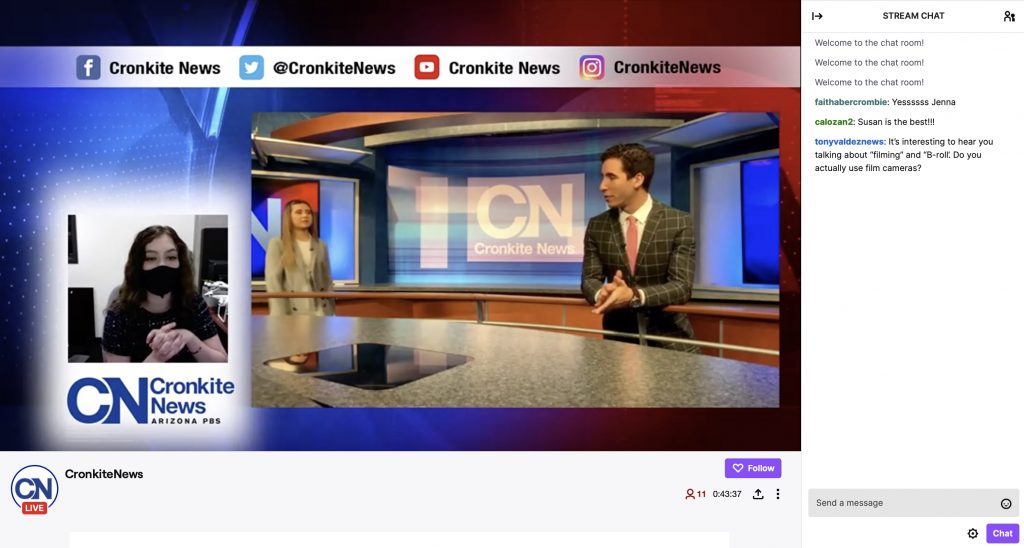
Most local TV stations use them — Facebook, Twitter, even Instagram. It’s 2021, after all. But as Sarandon Raboin scrolled through her phone, checking her social media accounts, she wondered: Why aren’t newsrooms on Twitch?
Sure, the livestreaming platform, founded in 2011, is mostly known for its popularity among video gamers and the fans who watch them play. But it’s also expected to surpass more than 40 million monthly viewers by the end of this year, with more and more Twitch streamers offering up other types of interactive video.
“I’m on TikTok a lot, and I saw this trend of a lot of creators being like, ‘Hey, I’ll be streaming on Twitch,’” says Raboin, a senior here at Arizona State University’s Walter Cronkite School of Journalism and a producer with Cronkite News, the student-run news division of Arizona PBS. “I started to see more YouTube creatives or just people who aren’t necessarily gamers move to the platform. And I thought to myself: In the news, we’re all trying to get in contact with our audience. We want to know what our audience wants, we want to be able to have that real-time communication — so it would be really interesting and cool to use Twitch in the newsroom.”
She pitched the idea to her editors and they were onboard — even though many of them weren’t familiar with the service. One who was: Isaac Easley, an instructor in video journalism and innovation at Cronkite News, a 2012 alum of the Cronkite School, and a self-described “big Twitch guy.” He says the majority of users fall within the elusive 16-34 age bracket and that the chat feature on a successful stream feels “like a big party.”

“I like the community connection with the chat. You get to know other people,” says Easley. “I watch a podcast called Double Toasted. It’s pretty much two Black guys who talk about movies all the time, and I love the vibe. Twitch gets a younger demographic, and an interactive demographic as well. So we looked, and there were no other news stations using Twitch. I’m like, ‘Well, let’s see what we can do with it. Let’s give it a shot.’”
Last week, Cronkite News hosted four hour-long livestreams during the rehearsals for its daily newscast, which airs on Arizona PBS at 5:30 p.m. Each one offered viewers a behind-the-scenes look at a different aspect of the show: the weather forecast, the sports report, the control room, and the anchors. While one person roamed the studio with an iPad, another sat in front of a desktop computer, explaining through the webcam how each element of the program comes together and answering viewer questions ranging from “Why is that anchor standing on a wooden box?” to “What story are you most proud of?”
“People were asking about Reed’s suit and where he got it, so we got to talk about European fashion for a minute and ‘What’s important for anchors to wear and why?’” says senior Emma Parkhouse, a Cronkite News reporter and one of the Twitch hosts. “It was also awesome to explain journalism vocabulary, because if you say ‘B roll’ to someone on the street, the average person typically doesn’t know. So explaining things like voiceovers, teleprompters, scripting, ad libbing — that’s really fun.”

That opportunity to demystify the processes behind a finished news product was also one of the big reasons Cronkite News decided to try Twitch, according to executive editor Christina Leonard, who spent more than a decade at The Arizona Republic before joining ASU.
“For the general public right now, I don’t think it’s a secret that there’s a trust issue with journalism,” says Leonard. “Anything that we can do to help peel back that curtain, say, ‘This is what we’re doing, this is why we’re doing it,’ and try to repair those relationships is really critical for us. The industry, for so long, has been closed-doors. But with experiments like this, people can get a behind-the-scenes glimpse and see we’re working hard. We want to do the right thing, we’re trying to make the right decisions, and we are really interested in engaging with our audiences.”
Watch Tina Giuliano host the Twitch stream dedicated to Cronkite News’ control room and newscast production. (Courtesy of Cronkite News)
The streams saw viewer numbers fluctuate between about five and 30 people at any given time, but the number of Cronkite News subscribers grew with each show. “They weren’t blockbuster in terms of audience,” says Leonard. “But I think it was a good way for us to — number one — see what it takes to do it. Number two, it was just good for the newsroom and getting people excited about experiments like this, because it’s really important that we bake this culture of innovation into our newsroom and that they’re seeing it, embracing it, and coming up with more ideas.”
After the first round of streams, those Twitch ideas are already flowing. The Cronkite News team is talking about other time slots to try, other ways to promote their upcoming shows, and other established Twitch influencers they might connect with and learn from. If the experiment goes well in the long term, they could even monetize their content on the free platform. In 2019, Twitch streams generated an estimated $300 million in ad revenue. And once streamers reach certain benchmarks, they can set up subscriptions as a way to offer special features to their users and generate additional revenue.

Raboin says she’s excited at the possibility of livestreaming in the field once the technology setup has been refined: “Take it back to this last summer — the protests. You could stream and have your anchor talk about it live. I think there’s potential with that.” Meanwhile, Easley sees a chance to help new journalists build their confidence and experience: “You get maybe someone who’s not ready to be an anchor? They could be the Twitch host — that new vibe, that new energy. So we can get younger blood into newsrooms earlier, which is good.”
For now, though, what advice does Cronkite News have for other TV stations thinking about trying Twitch for the first time?
- Embrace the informal tone. “It’s all about the live factor, and it’s like you’re chatting with someone you know and you’re friends with,” says Raboin. “We want to seem approachable.” Parkhouse calls it the “entertainment aspect.” In the newscast and on other platforms, she says, “we give you all the good information and inform the community the way that we’re supposed to as journalists — but sometimes, we’ve got to have fun.”
- Plan ahead and prepare your hosts. “To keep people’s eyes, you have to do some pre-production,” says Easley. “Of course it’s free-flowing, but you have to have a little bit of a direction.” He suggests preparing a variety of talking points so hosts are ready for slower stretches without viewer questions. Another tip? Showcase the right voices: “The way you draw your audience is going to be based on your host. So it’s got to be fun and informative. It’s got to be fly.”
- Test your tech and be ready to troubleshoot. “It’s like learning any new social media, right? There’s going to be a little bit of a learning curve,” says Raboin, who says there were some on-air struggles with volume. “I had to switch mics in the middle. At one point, I was really struggling putting my mic on, and I got so many questions in the chat, like, ‘Hey, why is it hard to put on the mic?’ They were able to see I’m able to laugh at myself. It shows we’re all human and we’re just people, and I think that was really cool to see.”
- Don’t feel pressured to narrate every second. “You don’t have to chat the entire time,” says Raboin. “It’s kind of like play-by-play for sports. Speak about 70% of the time, and sometimes they can just watch.” She says those moments without commentary are when your backdrops and visuals can really shine.
“I don’t know that Twitch is going to be the end-all, be-all,” says Christina Leonard. “But I think it’s another thing we can add to our toolbox to introduce younger viewers to what we’re doing, how we’re doing it, and also build more of that trust.”
If your newsroom has tried Twitch or has plans to try it, let us know about your experience by writing to us at cronkitenewslab@asu.edu.
EDITOR’S NOTE: Cronkite News is experimenting with Twitch as part of Table Stakes, an initiative that supports innovation in local TV news with funding from the Knight Foundation. Our work at the News Lab is funded through the same grant.